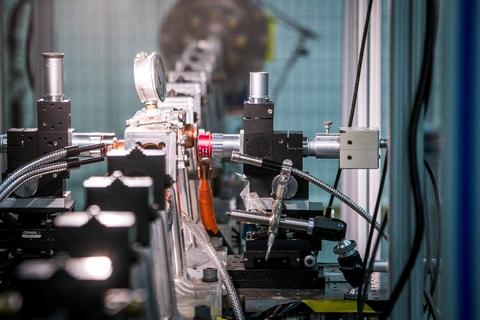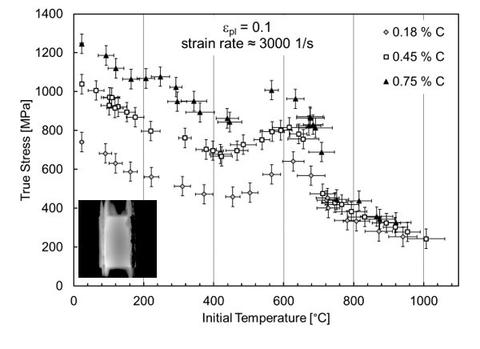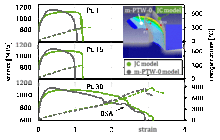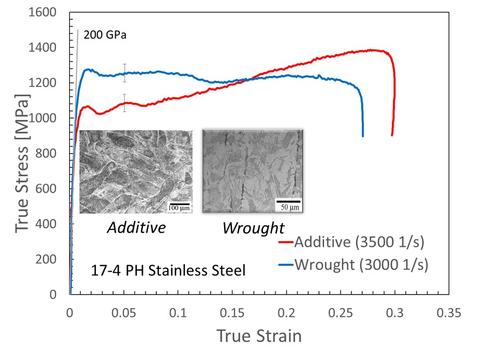Summary
This project provides property data, new metrology and contributes to standard test method development for materials systems subject to extreme mechanical and thermal loading with impacts areas including advanced manufacturing, homeland security, and safety infrastructure. The current focus is to develop measurement techniques and data to describe extreme, dynamic plastic behavior of metals where rapid heating can induce non-equilibrium behavior, with application to machining of wrought and additive metals and other dynamic additive manufacturing and forming processes, and to ballistic impact events.
Description

The optimization of high-speed machining processes through powerful finite element modeling techniques is an important pathway to American manufacturing competitiveness in an increasingly competitive global marketplace. Quantitatively accurate simulations of machining rely on robust constitutive models of workpiece materials under machining conditions. To this end, the Materials Science and Engineering Division has developed measurement methods for the deformation behavior of steels at high strain rate and high heating rate using a unique, electrically pulse-heated Kolsky bar.
During rapid heating induced by high-speed plastic deformation and friction, metal workpiece materials can be heated to temperatures where the initial metallic structure becomes unstable, changing the landscape through which dislocations are driven by applied stresses, through changes in grain size, crystal structure, precipitate size and morphology, etc. However, these changes are often diffusion-based and take more time than is available during the dynamic process. As such, plasticity occurs within un-transformed or partially-transformed microstructures that do not exist under ordinary mechanical testing conditions, leaving a critical data gap preventing accurate simulation and optimization of many dynamic processes.
Major Accomplishments

In 2019, a comprehensive set of rapidly-heated dynamic compressive measurements of three hypoeutectoid plain carbon steels with increasing levels of carbon were analyzed and disseminated to the materials community (figure at right shows thermal softening data for three carbon steels) austenite transition temperature (near 700 °C), after which rapidly-heated data begin to display different properties. In 2020, the time-dependent behavior of carbon steel in this region will be

probed experimentally with enough resolution to develop plasticity models that capture austenite transformation kinetics under rapid heating, using this dataset as a baseline and building on the first NIST measurements showing time-dependent plastic behavior in carbon steels [G2016-0841] In 2020, these new models were applied to simulate the machining of AISI 1045 steel in collaboration with the Technical University of Vienna, in Vienna, Austria, and Nordmetall GmbH in Chemnitz, Germany [G2021-0407]. The results showed promising improvements in the predictions of cutting forces, chip thicknesses and chip temperatures compared to the traditional material modeling approaches, as shown in the figure above.
The pulse-heated Kolsky bar technique has also recently been applied to additively manufactured (AM) metals to lay a foundation for understanding the machinability of this new class of materials. Secondary machining operations can be critical to the deployment of AM metals which usually fall short of dimensional and surface finish requirements in the as-built condition. NIST research has shown significant differences between the microstructure of AM materials and their traditional

counterparts additive project page], which ultimately means a different plastic response (figure at right compares dynamic stress-strain curves of AM and wrought 17-4 SS and corresponding microstructures) and, consequently, altered machinability. Current measurements focus on Inconel 625 and 17-4 PH stainless steel AM materials, the latter system which will also display time-dependent plasticity above 600 °C in both AM and wrought forms via copper precipitate growth [1].
Finally, the pulse-heated method is being applied to 6061-T6 aluminum, where growth of Mg-Si precipitates above 200 °C leads to time-dependent plasticity as shown by quasi-static testing in the literature [2] and confirmed by rapidly-heated dynamic experiments at NIST. The role of time-dependent dynamic plasticity has never before been explored in the context of either machining processes or ballistic impact mechanics in this important lightweight alloy. This work is being performed in collaboration with researchers at Wichita State University who provide complementary machining experiments and modeling.
[1] H.J. Rack and D. Kalish, “The Strength, Fracture Toughness, and Low Cycle Fatigue Behavior of 17-4 PH Stainless Steel,” Met. Trans., vol. 5, pp.1595-1605, 1974.
[2] D. Maisonnette, M. Suery, D. Nelias, P. Chaudet and T. Epicier, "Effects of Heat Treatments on the Microstructure and Mechanical Properties of a 6061 Aluminium Alloy," Materials Science and Engineering A, vol. 528, pp. 2718-2724, 2011.
Project Summary (PDF)

